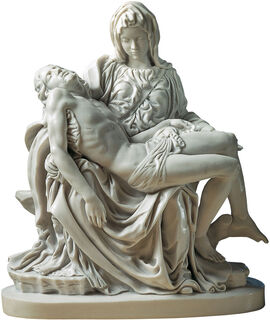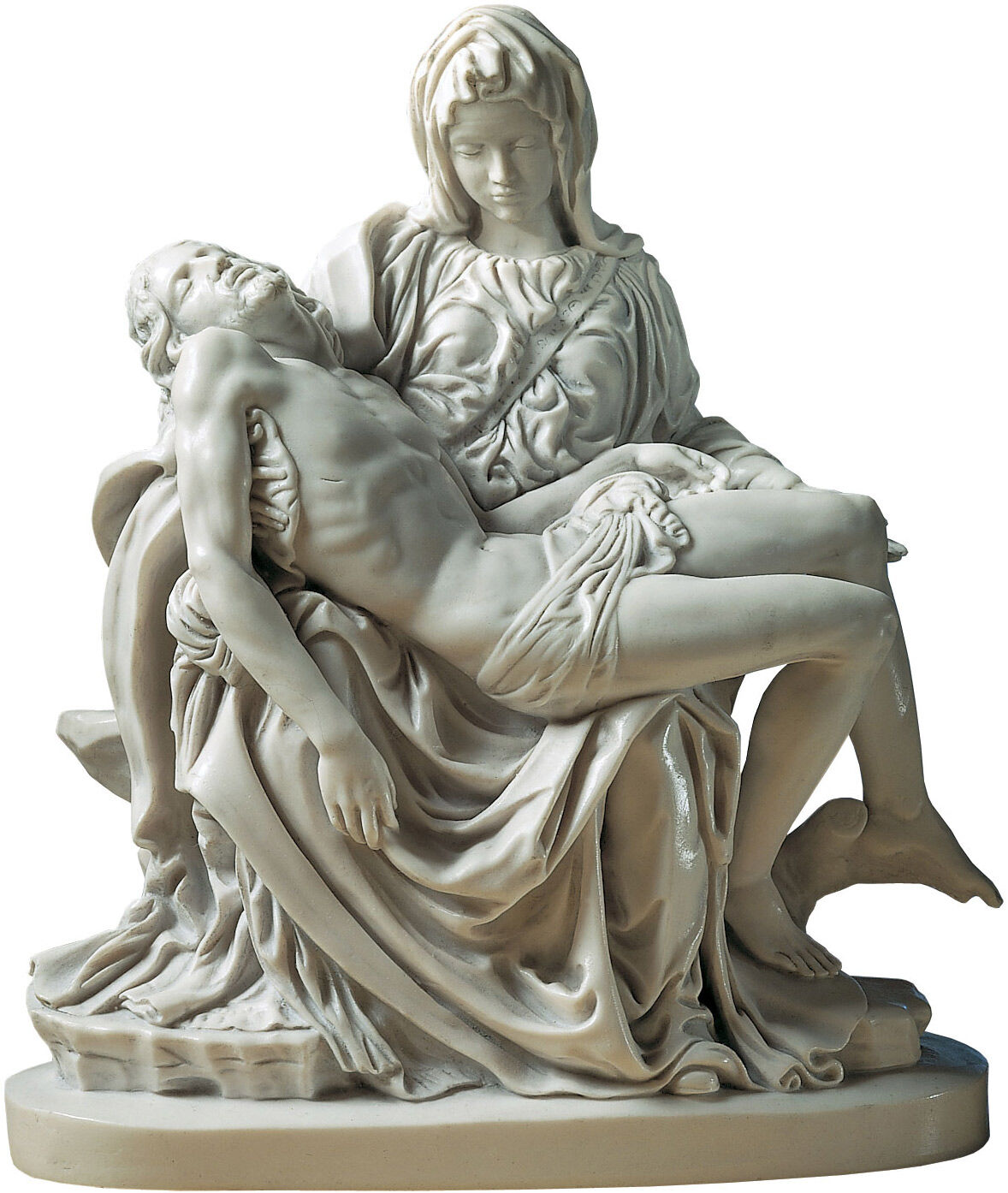Sculpture "Pietà" (1489-99), artificial marble reduction
Sculpture "Pietà" (1489-99), artificial marble reduction
Quick info
museum replica | artificial marble | handmade | reduction | size 23 x 29 x 14 cm (w/h/d)
Detailed description
Sculpture "Pietà" (1489-99), artificial marble reduction
Only 23 years old, Michelangelo created one of his most moving works with the sculptural group of the Mother of God with her Son - the only sculpture he ever signed. Mary's timelessly youthful face expresses a restrained pain, which is also evident in the devoted gesture of the left hand. Unlike the artists who sculpted this motif before him, Michelangelo does not emphasise pain as a prerequisite for redemption, but shows divine beauty as the result of redemption.
Original: St. Peter's Basilica, Rome.
Reduction. Polymer ars mundi museum replica, cast by hand. Size 23 x 29 x 14 cm (w/h/d).
Customer reviews
Die Figur hat meine Erwartung in vollem Umfang erfüllt. Sie war super sicher verpackt und wurde blitzschnell verschickt. Besser geht es nicht. Vielen Dank!
Ausführung eigentlich gut, aber Kunstmarmor für mein empfinden zu dunkel. Habe ich so nicht erwartet.
Wunderbare Skulptur
wunderbare Pieta, sehr schön gearbeitet
Eine wunderschöne, detailgetreue und qualitativ äußerst hochwertige Skulptur, die meine Erwartungen voll und ganz erfüllt. Sie war ein Geschenk und hat die beschenkte Person sehr glücklich gemacht! Großartig!
Hat meine Erwartungen voll erfüllt. Wunderschön und dem Marmor perfekt ähnlich. Danke!
Sehr schön
About Michelangelo Buonarroti
1475-1564
Michelangelo depicted pain and despair but also hope in his prehistory of mankind: the Sistine Chapel in the Vatican. When he created these vaulted frescoes between 1508 and 1512, the main representative of the High Renaissance and pioneer of Mannerism was already playing a central role in Italian artistic and intellectual life as a sculptor and painter.
Michelangelo Buonarroti was born in Caprese, Tuscany, in 1475. He trained as a painter under Domenico Ghirlandaio, and as a sculptor probably under Bertoldo di Giovannis, whereby the study of antiquity was a major influence.
From 1496 to 1501, Michelangelo worked in Rome, where among other projects he created the "Pietà" for St Peter's Basilica. Until 1504, he worked in Florence on the monumental statue of "David", which still shows the close connection to antiquity. The following sculptures mark the transition to Mannerism through intense moments of movement.
In 1505, Michelangelo received the commission for the tomb of Pope Julius II. However, it was only completed in a reduced way after his death in 1513 because the stubborn artist could not come to an agreement with the client. The "Bound Slaves" and "Moses" were created in 1516. He was to work as an architect for the Medicis but was unable to realise the planned building and instead implemented the design he had developed in the staircase of the Biblioteca Laurenziana in Florence, starting in 1521.
As of 1534, Michelangelo lived in Rome for good.
Michelangelo's late work is characterised by an intensive preoccupation with religious themes but also with architectural plans, such as the supervision of the construction of St. Peter's Church or the Palazzo Farnese. Through his letters and sonnets, we can also discover Michelangelo the poet, who died in 1564.
Marble powder is polymer-bonded. Artificial marble is characterised by a fine white surface that appears very similar to marble.
(Rebirth). The term describing art from around 1350 until the 16th century.
A mindset that developed in Florence in the late 14th century that was retrospectively classified as rebirth of the classical ideals of Greek and Roman antiquity. During the 15th and 16th centuries, the Renaissance spread first over Italy and then all over Western Europe and determined the entire artistic creation. Brilliant artists such as Donatello, Leonardo da Vinci, Michelangelo, Raphael, Dürer, Holbein, Cranach and Fouquet created their immortal works by following the humanistic premises and placing the human being in the centre of all thinking.
Renaissance experienced its heyday in literature through dramatic works and poems of William Shakespeare.
At the end of the 16th century, the Renaissance had to give way to the opulence of baroque, before its ideas experienced a rebirth in the classicism of the 18th century.
A true-to-the-original reproduction of an artwork in the same size and with the best possible material and colour uniformity.
The mould is usually taken directly from the original so that the replication reproduces even the finest details. After casting the replication, using the most appropriate method, the surface is polished, patinated, gilded or painted according to the original.
A replication of ars mundi is a recognizable copy of the original.
A plastic work of sculptural art made of wood, stone, ivory, bronze or other metals.
While sculptures from wood, ivory or stone are made directly from the block of material, in bronze casting a working model is prepared at first. Usually, it is made of clay or other easily mouldable materials.
The prime time of sculpture after the Greek and Roman antiquity was the Renaissance. Impressionism gave a new impulse to the sculptural arts. Contemporary artists such as Jorg Immendorf, Andora, and Markus Lupertz also enriched sculptures with outstanding works.


